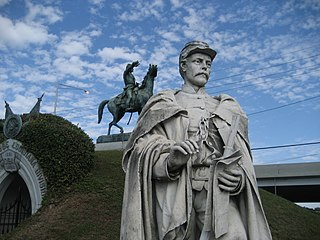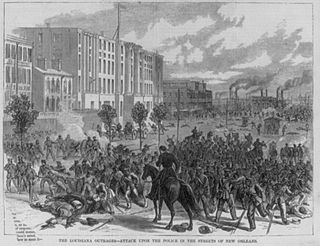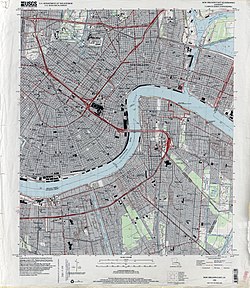
Metairie Cemetery is a cemetery in southeastern Louisiana. The name has caused some people to mistakenly presume that the cemetery is located in Metairie, Louisiana, but it is located within the New Orleans city limits, on Metairie Road.

Monument Avenue is a tree-lined grassy mall dividing the eastbound and westbound traffic in Richmond, Virginia, originally named for its emblematic complex of structures honoring those who fought for the Confederacy during the American Civil War. Between 1900 and 1925, Monument Avenue greatly expanded with architecturally significant houses, churches, and apartment buildings. Four of the bronze statues representing J. E. B. Stuart, Stonewall Jackson, Jefferson Davis and Matthew Fontaine Maury were removed from their memorial pedestals amidst civil unrest in July 2020. The Robert E. Lee monument was handled differently as it was owned by the Commonwealth, in contrast with the other monuments which were owned by the city. Dedicated in 1890, it was removed on September 8, 2021. All these monuments, including their pedestals, have now been removed completely from the Avenue. The last remaining statue on Monument Avenue is the Arthur Ashe Monument, memorializing the African-American tennis champion, dedicated in 1996.

Mitchell Joseph Landrieu is an American lawyer and politician who served as Mayor of New Orleans from 2010 to 2018. A member of the Democratic Party, he previously served as Lieutenant Governor of Louisiana from 2004 to 2010.

Alexander Doyle (1857–1922) was an American sculptor.

William Harold Nungesser is an American politician serving as the 54th lieutenant governor of Louisiana since 2016. A member of the Republican Party, Nungesser is also the former president of the Plaquemines Parish Commission, having been re-elected to a second four-year term in the 2010 general election in which he topped two opponents with more than 71 percent of the vote. His second term as parish president began on January 1, 2011, and ended four years later.

The Robert E. Lee Monument, formerly in New Orleans, Louisiana, is a historic statue dedicated to Confederate General Robert E. Lee by American sculptor Alexander Doyle. It was removed (intact) by official order and moved to an unknown location on May 19, 2017. Any future display is uncertain.

The Battle of Liberty Place, or Battle of Canal Street, was an attempted insurrection and coup d'etat by the Crescent City White League against the Reconstruction Era Louisiana Republican state government on September 14, 1874, in New Orleans, which was the capital of Louisiana at the time. Five thousand members of the White League, a paramilitary terrorist organization made up largely of Confederate veterans, fought against the outnumbered New Orleans Metropolitan Police and state militia. The insurgents held the statehouse, armory, and downtown for three days, retreating before arrival of federal troops that restored the elected government. At least 32 people, including at least 21 Neo-Confederate insurgents, were killed in the fighting. No insurgents were charged in the action.

Tivoli Circle is a central traffic circle in New Orleans, Louisiana, which featured a monument to Confederate General Robert E. Lee between 1884 and 2017. During this time the circle was known as Lee Circle until its name reverted to Tivoli Circle in 2022. The inner grass circle around the monument was renamed Harmony Circle at that time.
Confederate monuments and memorials in the United States include public displays and symbols of the Confederate States of America (CSA), Confederate leaders, or Confederate soldiers of the American Civil War. Many monuments and memorials have been or will be removed under great controversy. Part of the commemoration of the American Civil War, these symbols include monuments and statues, flags, holidays and other observances, and the names of schools, roads, parks, bridges, buildings, counties, cities, lakes, dams, military bases, and other public structures. In a December 2018 special report, Smithsonian Magazine stated, "over the past ten years, taxpayers have directed at least $40 million to Confederate monuments—statues, homes, parks, museums, libraries, and cemeteries—and to Confederate heritage organizations."

Appomattox is a bronze statue commemorating soldiers from Alexandria, Virginia, who had died while fighting for the Confederacy during the American Civil War. The memorial was located in the center of the intersection of South Washington Street and Prince Street in the Old Town neighborhood of Alexandria.

The Robert E. Lee Monument was an outdoor bronze equestrian statue of Confederate general Robert E. Lee and his horse Traveller located in Charlottesville, Virginia's Market Street Park in the Charlottesville and Albemarle County Courthouse Historic District. The statue was commissioned in 1917 and dedicated in 1924, and in 1997 was listed on the National Register of Historic Places. It was removed on July 10, 2021, and melted down in 2023.

The Robert E. Lee monument in Richmond, Virginia, was the first installation on Monument Avenue in 1890, and would ultimately be the last confederate monument removed from the site. Before its removal on September 8, 2021, the monument honored Confederate Civil War General Robert E. Lee, depicted on a horse atop a large marble base that stood over 60 feet (18 m) tall. Constructed in France and shipped to Virginia, it remained the largest installation on Monument Avenue for over a century; it was first listed on the National Register of Historic Places in 2007 and the Virginia Landmarks Register in 2006.

The Jefferson Davis Monument, also known as the Jefferson Davis Memorial, was an outdoor sculpture and memorial to Jefferson Davis, installed at Jeff Davis Parkway and Canal Street in New Orleans, Louisiana, United States from 1911 to 2017.

The Battle of Liberty Place Monument is a stone obelisk on an inscribed plinth, formerly on display in New Orleans, in the U.S. state of Louisiana, commemorating the "Battle of Liberty Place", an 1874 attempt by Democratic White League paramilitary organizations to take control of the government of Louisiana from its Reconstruction Era Republican leadership after a disputed gubernatorial election.

More than 160 monuments and memorials to the Confederate States of America and associated figures have been removed from public spaces in the United States, all but five since 2015. Some have been removed by state and local governments; others have been torn down by protestors.

The J. E. B. Stuart Monument is a deconstructed monument to Confederate general J. E. B. Stuart at the head of historic Monument Avenue in Richmond, Virginia, which was dedicated in 1907. The equestrian statue of General Stuart was removed from its pedestal and placed into storage on July 7, 2020 after having stood there for 113 years. The removal was in response to nationally reported events of police brutality and a corresponding emergency declaration in Virginia. The granite pedestal, which stood empty for nineteen months, was finally dismantled in February 2022.

The Stonewall Jackson Monument in Richmond, Virginia, was erected in honor of Thomas Jonathon "Stonewall" Jackson, a Confederate general. The monument was located at the centre of the crossing of Monument Avenue and North Arthur Ashe Boulevard, in Richmond, Virginia. The bronze equestrian statue was unveiled in 1919. Along this avenue are other statues including Robert E. Lee, J. E. B. Stewart, Jefferson Davis, Matthew Maury and more recently Arthur Ashe. Thomas Jackson is best known as one of Robert E. Lee's most trusted commanders throughout the early period of the American Civil War between Southern Confederate states and Northern Union states. He rose to prominence after his vital role in the Confederate victory at the First Battle of Bull Run in July 1861, continuing to command troops until his untimely death on May 10, 1863, after falling fatally ill following the amputation of his wounded arm.




















